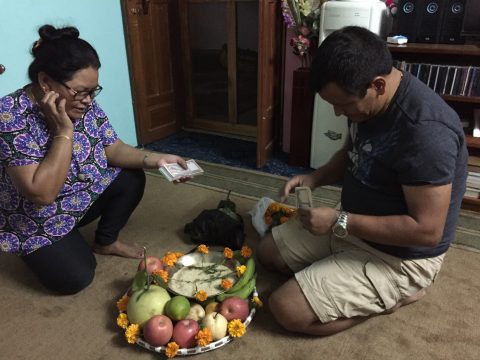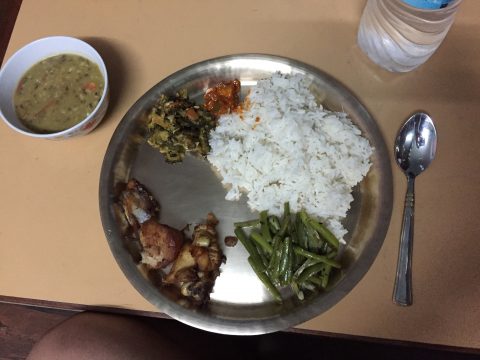Active Mind, Creative Spirit
Answers to your Questions
Only so much can be relayed in a FB post. Since I’m staring at the ceiling at 3 am, I thought I’d dig in. Ask me about anything and I am happy to expound. This will also fill in some of the story gaps from photos and video I’ve posted lately.
Why the face masks?
You’ve noticed the masks on a large fraction of the people of Kathmandu. It’s because the air quality sucks. It’s a combination of diesel (their trucks cough black crud) and dust (the Indian subcontinent is famous for its dust. It collects on everything. It’s a little better this visit, since I am here after the rainy season rather than before, but shop keepers routinely sweep off their goods during open hours. Will I use one? I packed a cloth I could use if I need to, but from what I’ve read, it doesn’t help much. Particles are too small for anything other than a full respirator, and those aren’t commonly seen here. Breathing through clean cloth makes the air smell better though. If there was one thing in all of Kathmandu I could change, it would be the air quality.
What is Tihar?
Also called Diwali among Buddhist folks, it’s the equivalent of Christmas, but also of fall harvest and thanksgiving. Lights are strung, alters and homes are decorated with strings of marigold flowers, large meals are prepared, and about 5 days are set aside to celebrate. Each day has a specific mission. Day 2 was honoring and thanking animals for what they provide (from companionship to work burden, to food). Day 3 is lights and sand decorations (Hindus decorate the roads and floors outside their homes with the colored powder you saw in the markets). Day four is for honoring your brother – Danu, my host yields everything to his sisters that day and they honor him for being their protector and provider. He’s the youngest of 16 siblings, many of whom are sisters. He’s told me I can photograph it. 🙂


Your flight to Kathmandu – how was that?
Ok, nobody asked me that, but there’s a story. (First, my 17 hour flight to Singapore sat me next to two gorgeous young ladies from Brooklyn on their way to Bali for a yoga workshop. It was their first trip to Asia, so you KNOW I had fun with that!)
But on to the KTM flight. Most of the 200 of us on the flight to Kathmandu were Nepal natives returning home though they live abroad. I estimated 1 in 5 on the flight was Western, as the fall trekking season is full tilt right now. So WHO did I sit next to, of all the people? A Nepali musician. Of course! He’s living in Brisbane, playing music with an Australian fusion group who travels the world doing folk festivals. If you know me, you just laughed out loud… Because I wrote an entire 300 page book about Nepali musicians who walked with me up the Everest Highway 7 years ago. So, I happen to have dug the last copy I have of that book out (after letting it hide in a trunk for 4 years) and was planning to read it through on the flights, to cringe one more time, but also to remember all the things I might have forgotten. So there it was in my seat pocket when we began talking. He remembered hearing about that tour which AC led, and knew most of the musicians I call friend/family, and even toured with Mausami (“Oh, give her my regards, it’s been 10 years!”). So you can see that whether its luck or a small community, I run into “my people” everywhere. I pulled my book out and handed it to him. He gasped and smiled, seeing photos of Mausami for the first time in a long while. He read an entire chapter before he handed it back (he picked a really good chapter – the one where the guest musicians fly in for one concert) so I got to relay the parts of that story that aren’t in the book, and he, about those very musicians who flew in, and we spent the rest of the flight discussing cultural classes, castes, political intricacies, and progress (it’s the Salleri Concert chapter if you’re interested). It was a blast to get his perspective.
What’s the weather like and what are you doing when you get there if you’re not with a trekking group?
Depends on where you are – but it’s clear I packed for cooler weather than I will probably encounter. Ktm was near 80 yesterday and that’s cooler than it has been. RIght now, the open window blowing on my toes is about 55, so it’s a nice range. I do plan to get to Chitwan, the hot, southern end on the Ganges flood plain. It will be hotter there. And sticky. Kathmandu is pretty dry. I knew there was a possibility of getting to Tibet – I have been nudging all my contacts for 2 weeks about a China visa and planned to spend a few days seeing Lhasa – the seat of Tibet, and home to the largest Tibetan Buddhist (that’s what Sherpas are) monastery. But Tibet is closed for business. China shut it a couple weeks ago, and no one is getting in. In case you were wondering how Tibet is faring… Sigh. So my next choice is Annapurna (one of the 8000M peaks on the border of Nepal and Tibet), if I don’t get a really wild hair and go to Darjeeling, Kashmir or Pakistan (hey, it’s not that far away!) 🙂
What’s the road situation?
You might have noticed the roads are pretty rough (if you haven’t, more footage to come). Part of it is just lack of infrastructure (Nepal maintains the “poorest country in Asia” label) and part of it is politics. It isn’t always clear who owns what, so taking ownership of maintaining a sidewalk or road is dodgy. At any time the government could decide to tear up the one in front of your home and claim an extra 10 feet for pipe placement or other development. Most cars and motorbikes get along fine, and people just deal. On the up side, they are dropping in sewer and water pipes in many parts of the city.
What’s changed since you were here last?
Everything and nothing. The earthquake (where over 8000 Nepali people died) was more than 2 years ago and I haven’t been here in that time, but most of the large temples, structures and some homes have been completely rebuilt since then. There was no government pay out or financial help for anyone who lost a house, but they rebuilt anyway. They are a resilient people. Boudhanath’s top section came completely off and they just finished restoration on that a few weeks ago. There is visible construction that might yield better water and sewer conditions, and they have a sort of garbage pick up service now. That’s new – family garbage burning is down quite a bit, but used to be the main method for removing trash. I think that’s helping the air quality. Yesterday a guy in an open-bed truck blew a whistle as he approached, and a member of each house ran out to throw their refuse in. It costs $4 per month for the service, and is mandatory in some areas where there is no acceptable space to burn. Last major change: they are accustomed to 14-hour rolling blackouts, and the city has thousands of gas-driven generators that run while power is out. But the blackouts are not universal anymore. Several people have said, yes, there are no more blackouts in Kathamandu, but Danu says his home is still without power regularly. He is also one of the private homes with a converter (turns other generator on automatically when the power goes down). So that may be contributing to better air as well. It seems not as thick. My eyes don’t burn from diesel as they have in previous visits. (Erika, WHY do you go there! – I know!)
Finances? In asking what things cost, a prepared chicken (whole, defeathered, ready to cook) costs about $7 US, and locals can eat a lunch meal for about $4 US. Annual average income is up a bit, but still hangs around $600 US per year. It’s unclear to me if that takes all working-able folk and divides the total incomes, or if it takes an average among wage earners. The contrast would be stark, as often a household has 4-8 potential wage-earners, and only 2 have income. Ok, I’m getting deep and perhaps boring now…
The bats have been chirping outside my window as I wrote this, and now the chickens are joining them… time to scoot.
Back to photos. Ask more questions if you have them! Here’s what I ate for dinner last night: Fried chicken, lentil soup (yes, dal), curried tete carela (biter melon), green beans, mango pickle (hot, unsweet chutney), rice and white wine.
